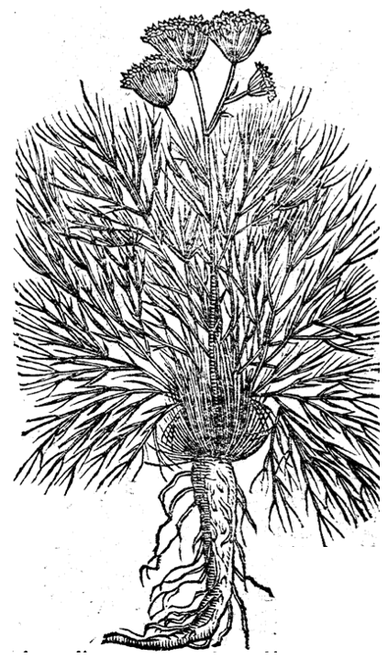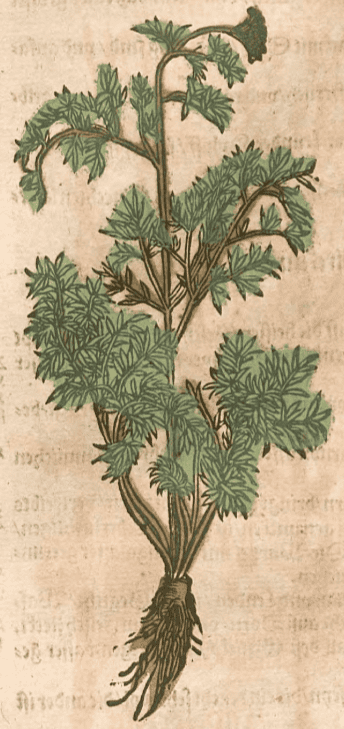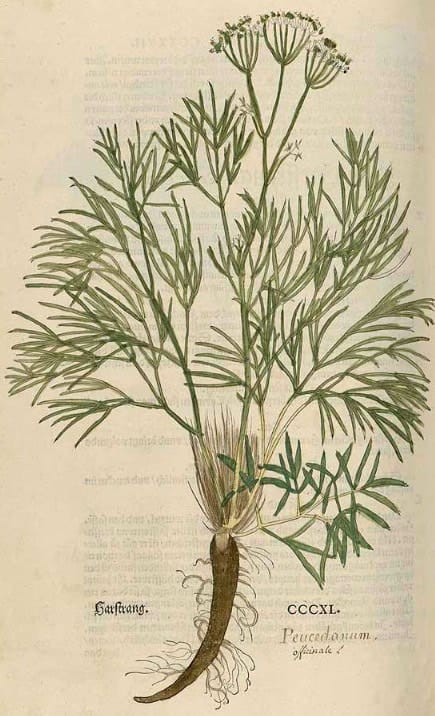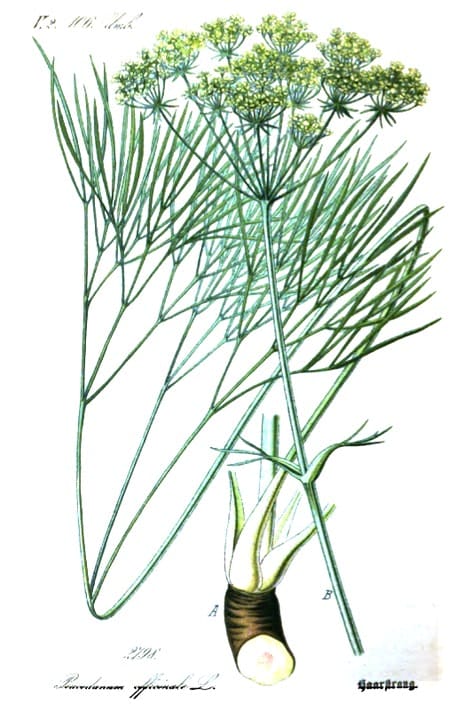Peucedanum, Hog-fennel, Qian Hu 前胡
Sulphur-wortQian Hu (Chinese local species)
Tang kun, lcha ba (Tibetan, local species)

|

|
|
Dioscorides Materia Medica, Mathias, 1563 |
Krauterbuch, Lonitzer, 1578 |
 Peucedanum officinale
Peucedanum officinaleFuchs, L., New Kreüterbuch, (1543)
 Flora von Deutschland (27), Kohler, 1886
Flora von Deutschland (27), Kohler, 1886Botanical name:
Peucedanum officinale (West)
TCM uses White and Purple flowered varieties including:
- P. decursivum (syn. Angelica decursiva)–official species
- P. praeruptorum–official species
- P. longshengens
- P. rubricaule
- P. terebinthaceum
- P. medicum
Parts used:
Root; also the Juice
Temperature & Taste:
Warm, dry. Pungent (considered Slightly Cool in TCM)
attenuating, inciding, opening, cleansing
Classification:
P. Clear Cold Phlegm / P. Clears Hot Phlegm
Uses:
1. Clears Cold Phlegm: (TCM, West)
-Cough, Asthma, Shortness of Breath with thick, hard-to-clear Phlegm (Syrup)
-Cold Phlegm of the Lungs, Bowels, Uterus and Kidneys
-in TCM for thick Phlegm obstructing the Chest (more often for Phlegm-Heat)
2. Warms the Stomach, Eases Pain:
-Colic, Flatulence, Meteorism and other digestive disorders
-the Chinese species has been shown to inhibit gastric ulcers and stop gastric spasms
-‘causes an Appetite’.
3. Clears Wind-Phlegm, Stops Spasms:
-Cramps, Epilepsy, Dizziness, Vertigo
-Apoplexy, Paralysis and Lethargy
–Qian Hu was listed for Wind-Phlegm diseases in older TCM texts
-Wind-Phlegm disorders (Tibet)
-Night-crying in babies (Ben Cao Gang Mu)
4. Clears Wind-Damp, Promotes Urine: (West, Tibet)
-Strangury, Dysuria, Edema (West0; Kidney disease in Tibet
-Kidney or lower back pain (West, Tibet)
-Gravel, Stones.
-Puffiness of the Eyes (Ben Cao Gang Mu)
5. Moves the Qi and Blood, Promotes Menstruation: (West)
-Amenorrhea and Dysmenorrhea
-cramps and pain of the Uterus; Hysteria.
-Expels a Dead Fetus.
-Bruises, Trauma, and all cases with ‘Congealed and Clotted Blood’.
-the Chinese varieties have been shown to increase blood flow.
6. Resists Poison, Promotes Sweat: (West)
-acute Wind-Cold or Wind-Heat Colds and Flu
-TCM uses it for acute Wind-Heat; however, excess Phlegm is still a primary indication.
-all Cold Poisons; Fever due to poisoning in Tibet
-Bites of Venomous Beasts;
-Syphilis
-Quartan [Malarial] Fevers.
7. Externally:
–Numbness, Sciatica, Spasms, Convulsions,
-Hernias
-old Sores and Ulcers, Tumors
-cold Headaches and all cold diseases
-juice dropped into the ears for Pain, Deafness and Tinnitus from Cold and Wind
Dose:
Decoction: 3–9 grams
Powder: 1–3 grams
Comment:
1. The European and Chinese species are very similar. This is seen in the fact that P. officinale (the European variety) is called Yao Yong Qian Hu, ie. a variety of ‘Qian Hu‘ (the Chinese name of Peucedanum).
2. In TCM, Qian Hu is accounted slightly Cool, and is primarily used for Phlegm obstructing the Lungs with Cough and Wheezing. It is believed to have a special function of promoting downward movement of Qi. This leads the Fire back to its source in the lower abdomen while simultaneously clearing Phlegm. in the West, Hog Fennel (also called Sulphurwort) is classed as Warm, and therefore more used for Cold Phlegm. We believe Peucedanum can be used for both Hot and Cold Phlegm disorders depending on the herbs its used with.
3. The primary function is to clear Phlegm obstructing the Chest. The Chinese Qian Hu is a suitable substitute for the rarely available Hog Fennel, used in the Western Tradition. It is also likely that the Chinese species can be used for the other functions listed above.
Main Combinations:
1. Phlegm obstructing the Lungs:
i. Peucedanum Qian Hu is often combined with Cynanchum Bai Qian in TCM for Cough that hasn’t cleared after an acute attack (Cold or Flu). (TCM)
ii. Peucedanum with Almonds
iii. with Lung Heat, Peucedanum Qian Hu with Mulberry root bark (Sang Bai Pi), Almond (Xing Ren), Fritillaria Bei Mu
2. Acute Wind-Heat (Common Cold or Flu), Peucedanum Qian Hu with Peppermint (Bo He), Platycodon Jie Geng, Burdock seed (Niu Bang Zi). (TCM)
3. Lower Back pain, Peucedanum with Asparagus root, Frankincense, Indian Spikenard, Cinnamon, Costus (as in Electuary for Back Pain of Galen)
4. Vertigo, Peucedanum with Thyme, Marjoram, Betony, Rosemary, Aniseed, Peony root, Aloeswood (as in Tincture for Vertigo)
5. Tuberculosis, Peucedanum Qian Hu with Pig Spine, Big Bile, Urine of an Boy (under 10), Soloman’s Seal (Yu Zhu), Picrorhiza Hu Huang Lian, Bupleurum Chai Hu (Ben Cao Gang Mu)
6. Puffiness of the Eyes, Peucedanum Qian Hu, Semiaquilegia Tian Kui Zi, Poria Fu Ling, Soloman’s Seal (Yu Zhu) (Ben Cao Gang Mu)
Major Formulas:
Electuary of Horehound Diaprassium
Electuary for Back Pain of Galen
Tincture for Vertigo
Cautions:
1. Not used for Yin deficiency.
2. Caution during Pregnancy
Main Preparations used:
Distilled Water of the Herb and Root
